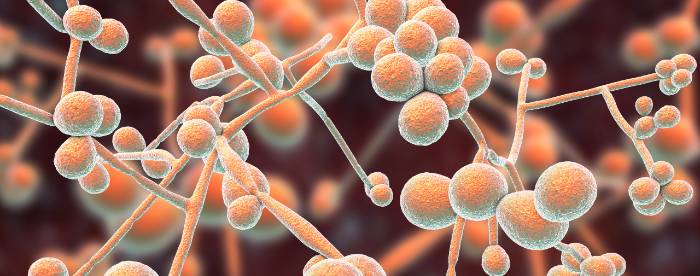Candida auris Rapidly Recontaminates Surfaces Around Patients’ Beds Despite Cleaning and Disinfection
Candida auris environmental contamination is unlikely to be adequately controlled because re-contamination occurs within hours after disinfection.
Candida auris (Adobe Stock)

Candida auris (C auris) recontaminates environmental surfaces within a patient’s room within hours despite regular cleaning and disinfection. C auris is an emerging multidrug-resistant yeast that is often associated with substantial morbidity and mortality and is often transmitted in health care facilities. Investigators suspect environmental contamination plays an important role in transmission, but additional information is needed to inform environmental cleaning recommendations to prevent spread.
A recent study about this topic, “Multicenter Evaluation of Contamination of the Healthcare Environment Near Patients with Candida auris Skin Colonization,” funded by the Center for Disease Control (CDC) Foundation, was presented at the Society for Healthcare Epidemiology of America (SHEA) Spring conference, held April 12-14 in Colorado Springs, Colorado.
“Environmental surfaces near C auris-colonized patients were rapidly recontaminated after cleaning/disinfection. Cocolonization of skin and environment with other multidrug resistant organisms (MDROs) was common, with resistant Gram-positive organisms predominating over Gram-negative organisms on environmental surfaces.” Sarah Sansom, DO, MS, attending physician of infectious diseases, Rush University Medical Center, Chicago, Illinois, and coauthor of the study, told Infection Control Today® (ICT®). “Rapid re-contamination of environmental surfaces after manual cleaning/disinfection suggests that alternate mitigation strategies should be evaluated.”
Sansom also credited the main co-author of the study, Gabrielle Gussin, ASPPH, and the principal investigators on the study, Mary Hayden, MD, Rush University Medical Center; and Susan Huang, MD, MPH, University of California Irvine.
The prospective study on environmental contamination associated with C auris colonization of patients and residents of 1 skilled nursing facility in Chicago, Illinois, and 1 acute-care hospital and 5 skilled nursing facilities in Orange County, California. Samples were collected from participants’ body sites, including nares, axillae, inguinal creases, palms/fingertips, perianal skin, and their environment before room cleaning. The participants in the study were identified by screening or clinical cultures.
Facility environmental service technicians conducted daily room cleaning and disinfection and then was followed by targeted cleaning of high-touch surfaces by research staff using product hydrogen peroxide wipes, an Environmental Protection Agency (EPA)-approved for C. auris.
Samples were collected immediately post-cleaning from high-touch surfaces and repeated at 4-hour intervals up to 12 hours. A pilot phase (n = 12 patients) was conducted to identify the value of testing specific high-touch surfaces to assess environmental contamination. High-yield surfaces were included in the full evaluation phase (n = 20 patients). For the study, samples were submitted for semi-quantitative culture of C auris and other multidrug-resistant organisms (MDROs) including methicillin-resistant Staphylococcus aureus (MRSA), vancomycin-resistant Enterococcus (VRE), extended-spectrum beta-lactamase-producing Enterobacterales (ESBLs), and carbapenem-resistant Enterobacterales (CRE). Investigators analyzed time to room surface contamination with C auris and other MDROs after effective cleaning.
Results demonstrated C auris colonization was most frequently detected in the nares (72%) and palms/fingertips (72%). Cocolonization of body sites with other MDROs was common. Some of the internal room surfaces tested included bed handrail, remote/call button, nightstand, footboard, and overbed table. These surfaces are also the most likely to be re-contaminated following surface cleaning within hours of disinfection.Surfaces located close to the patient were commonly recontaminated with C auris by 4 hours after cleaning, including, overbed table (24%), bed handrail (24%), and remote/call button (19%). However, environmental cocontamination was more common with resistant Gram-positive organisms (MRSA, VRE), than resistant Gram-negative organisms. C auris was detected rarely from surfaces located outside of a patient’s room (1/120 swabs; less than 1%).
Yet, Sanson told ICT®, “More frequent cleaning is unlikely to provide adequate control of C auris environmental contamination because contamination occurs within hours after disinfection. Importantly, very little C auris was detected from surfaces outside of the patient's room (ie nursing station, shared equipment carts, doorknobs, etc).” However, one of the limitations of the study included lack of organism sequencing or typing to confirm the environmental contamination was from the room resident.
Sansom said she and her colleagues “were surprised by how rapidly we observed surface contamination with C auris following cleaning.” She continued, saying that future research includes “working to evaluate clinical risk factors that may contribute to environmental surface contamination, such as patient care needs and bioburden of colonization at different body sites.”
The investigators’ future goal “is to use this information to develop bundled interventions to help control the spread of C auris in health care facilities,” Sansom told ICT®.